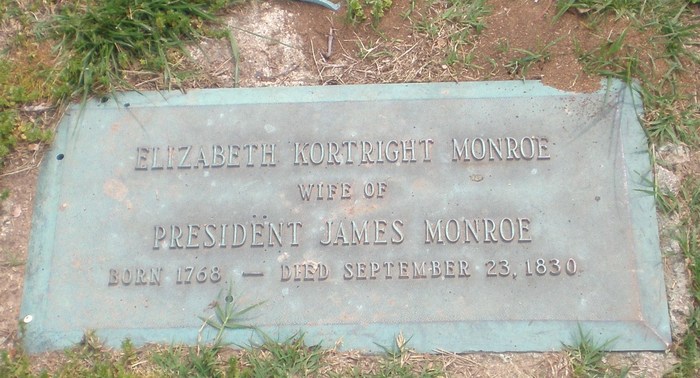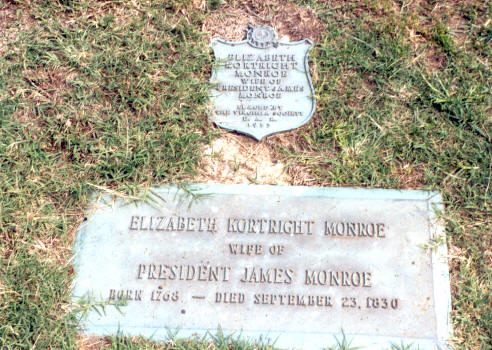Elizabeth Monroe (Elizabeth Monroe)

Elizabeth Monroe
Born in New York in 1768, Elizabeth was the daughter of Lawrence Kortright and Hannah Aspinwall, 6th generation of Dutch Flanders origins. Lawrence Kortright the eldest son of Cornelius Kortright, also a merchant. During the French Indian wars, he became wealthy and prominent. He was part owner of several privateers fitted out at New York against the enemies of the British Crown . He was one of the founders of the Chamber of Commerce in 1768. He had a large interest in Tryon County lands, and on his purchase the township of Kortright was settled. He had identified himself with the Episcopal Church, and during the Revolution remained quiet at his residence, but his sympathies were with his country. His residence was 192 Queen Street about the time mentioned. In 1778, partly on his security, Judge Fell, then a prisoner in the Provost, obtained his release. He died in 1794, but before his death he conveyed his farm at Harlem with some woodland, to his only son, John, Elizabeth’s older brother. Elizabeth acquired social graces and elegance at an early age. A gown in the collection of the James Monroe Museum indicates she was a petite woman, not taller than 5 feet. She first caught Monroe’s attention in 1785 while he was in New York serving as a member of the Continental Congress. James, age twenty-seven, married Elizabeth, age seventeen, on February 16, 1786, in New York City. After a brief honeymoon on Long Island, the newlyweds returned to New York to live with her father until Congress adjourned. Their first child, Eliza, was born in December 1786 in Virginia.
In 1794, James was appointed United States Minister to France by President George Washington. In Paris, as wife of the American Minister during the Reign of Terror, she helped secure the release of Madame La Fayette, wife of the Marquis de Lafayette when she learned of her imprisonment and threatened death by guillotine. The Monroes also provided support and shelter to the American citizen Thomas Paine in Paris, after he was arrested for his opposition to the execution of Louis XVI. While in France, the Monroes’ daughter Eliza became a friend of Hortense de Beauharnais, step-daughter of Napoleon, and both girls received their education in the school of Madame Jeanne Campan, who had been an advisor on court etiquette to Marie Antoinette. This association led to a friendship between the family of Napoleon Bonaparte and the Monroes.
James was recalled from his Ambassadorship in 1796, due to his support of France in the opposition of the Jay Treaty. The Monroes returned to Virginia where he became Governor. A son, James Monroe, Jr., was born in 1799 but died in 1801. In 1803, President Jefferson appointed James to be United States Minister to Great Britain, and also the United States Minister to Spain. The Monroes’ third child, a daughter whom they named Maria, was born in 1803, probably in England. In 1804, James was sent as a special envoy to France to negotiate the purchase of Louisiana, in addition to remaining the Ambassador to both Great Britain and Spain. In December 1804, he and Elizabeth were invited by Napoleon to attend his coronation in Paris, and were part of the official American delegation. The Monroes returned to Virginia in 1807.
James Monroe returned to the Virginia House of Delegates and was elected to another term as governor of Virginia in 1811 but served only four months. In April 1811 he became Secretary of State. He had little to do with the War of 1812, as President Madison and the War Hawks in Congress were dominant. The war went very badly, so Madison turned to Monroe for help, appointing him Secretary of War in September 1814. Monroe resigned as Secretary of State on October 1 but no successor was ever appointed so he kept doing the work. Thus from October 1, 1814, to February 28, 1815, Monroe effectively held both cabinet posts. Monroe formulated plans for an offensive invasion of Canada to win the War of 1812, but the peace treaty was ratified in February, 1815, before any armies moved north. Monroe therefore resigned as Secretary of War and was formally reappointed Secretary of State. Monroe stayed on at State until March 4, 1817, when he began his term as the new President of the United States. During the War of 1812, Elizabeth stayed primarily on the Monroe family estates near Loudon and Albemarle, Virginia.
Elizabeth began her tenure as First Lady on March 4, 1817, when her husband commenced his first term as the fifth President of the United States. Her husband was re-elected to a second term in office in 1820, therefore she remained in her role of First Lady until March 3, 1825. Although Elizabeth Monroe regained a measure of respect and admiration during her husband’s second term, she compared poorly to her predecessor, Dolley Madison, who had captivated Washington society, setting a standard by which future First Ladies were measured.
Retiring sickly and suffering several long illnesses, Elizabeth died on September 23, 1830 aged 62, at her home, Oak Hill. She was interred at Hollywood Cemetery in Richmond, Virginia. The First Spouse Program under the Presidential $1 Coin Act authorizes the United States Mint to issue 1/2 ounce $10 gold coins and bronze medal duplicates to honor the first spouses of the United States. Elizabeth Monroe’s coin was released in February 2008.
Born
- June, 30, 1768
- New York, New York
Died
- September, 23, 1830
- Richmond, Virginia
Cause of Death
- after suffering several long illnesses
Cemetery
- Hollywood Cemetery
- Richmond, Virginia



